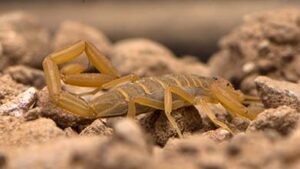Scorpions are nuisance pests and are also of medical importance because of their stings. Their stings can result in a mild wasp-like sting, which can be complicated by an allergic reaction and can be fatal in rare instances. In Arizona, there are a number of species, however, the Arizona Bark Scorpion is the one of most concern and the most dangerous in the U.S.
Quick Stats:
- Color: Light tan to dark brown
- Shape: Cephalothorax (fused head and thorax) elongate and dorsally shield-like, abdomen distinctly segmented, anteriorly elongate with last 5 segments tail-like, and ending in a sting.
- Size: 1 1/4 inch long
- Region: Found throughout the Southwest U.S. – desert climates
Habits:
Scorpions are nocturnal feeders. They feed mostly on insects and spiders and when water is available they can survive for months without food. During the day, scorpions usually hide either in or beneath something. If door thresholds are missing and/or unscreened windows are left open, they may enter directly into the living space.
Threats:
Stings are often very painful and are usually followed by immediate distress, including numbness around the wound, weakness or even paralysis of the injured part. Generally, children and the elderly are at risk, especially if found to be allergic to their sting.
Prevention:
Controlling scorpions is a five-step process:
- Identification.
- Harborage elimination.
- Food/prey reduction.
- Exclusion.
- Pesticide application if required.
A high-quality pest control program will include the 5 steps listed above; however, scorpions will travel quite some distance, so it is imperative to get your neighbors involved for a successful control of scorpions.
Did You Know? Scorpions…
- Litter size averages 20 to 47 babies that look like miniatures of mom.
- Can live for several months without eating.
- Can withstand temperatures from nearly freezing to 122° F.
- Can regenerate missing parts.
Scorpion Identification
Family
Arachnida/Scorpiones/Various
Color
Light tan to dark brown
Shape & Structure
Cephalothorax (fused head and thorax) elongate and dorsally shield-like, abdomen distinctly segmented, anteriorly elongate with last 5 segments tail-like, and ending in a sting.
Size
1¼ inch long
Region
Found throughout the Southwest U.S. – desert climates



